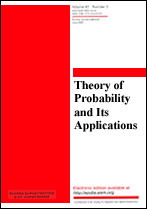|
This article is cited in 4 scientific papers (total in 5 papers)
On one limit theorem for branching random walks
N. V. Smorodinaabc, E. B. Yarovayadc
a St. Petersburg Department of Steklov Mathematical Institute of Russian Academy of Sciences
b Saint Petersburg State University
c Steklov Mathematical Institute of Russian Academy of Sciences, Moscow
d Lomonosov Moscow State University
Abstract:
The foundations of the general theory of Markov random processes were laid by
A. N. Kolmogorov. Such processes include, in particular, branching random
walks on lattices $\mathbf{Z}^d$, $d \in \mathbf{N}$. In the present paper,
we consider a branching random walk where particles may die or produce
descendants at any point of the lattice. Motion of each particle
on $\mathbf{Z}^d$ is described by a symmetric homogeneous irreducible random
walk. It is assumed that the branching rate of particles at $x \in
\mathbf{Z}^d$ tends to zero as $\|x\| \to \infty$, and that an additional
condition on the parameters of the branching random walk, which
gives that the mean population size of particles at each point $\mathbf{Z}^d$ grows exponentially in time, is met. In this case, the walk generation operator in the
right-hand side of the equation for the mean population size of particles
undergoes a perturbation due to possible generation of particles at points
$\mathbf{Z}^d$. Equations of this kind with perturbation of the diffusion
operator in $\mathbf{R}^2$, which were considered by Kolmogorov, Petrovsky,
and Piskunov in 1937, continue being studied using the theory of branching
random walks on discrete structures. Under the above assumptions, we prove
a limit theorem on mean-square convergence of the normalized number of
particles at an arbitrary fixed point of the lattice as $t\to\infty$.
Keywords:
branching random walk, the Kolmogorov equations, martingale, limit theorems.
Received: 17.05.2023
Accepted: 30.06.2023
Citation:
N. V. Smorodina, E. B. Yarovaya, “On one limit theorem for branching random walks”, Teor. Veroyatnost. i Primenen., 68:4 (2023), 779–795; Theory Probab. Appl., 68:4 (2024), 630–642
Linking options:
https://www.mathnet.ru/eng/tvp5609https://doi.org/10.4213/tvp5609 https://www.mathnet.ru/eng/tvp/v68/i4/p779
|


| Statistics & downloads: |
| Abstract page: | 172 | | Full-text PDF : | 4 | | References: | 39 | | First page: | 20 |
|




 Contact us:
Contact us: Terms of Use
Terms of Use
 Registration to the website
Registration to the website Logotypes
Logotypes








 Citation in format
Citation in format 
